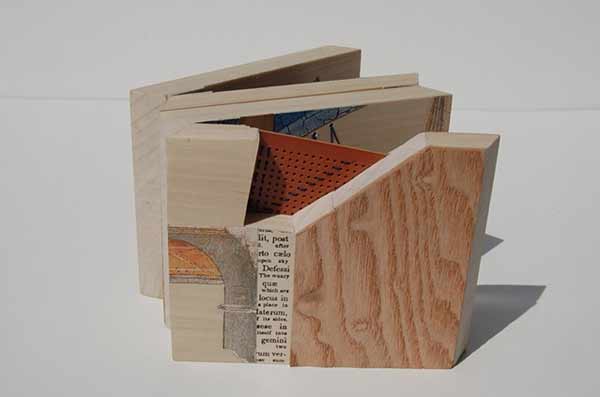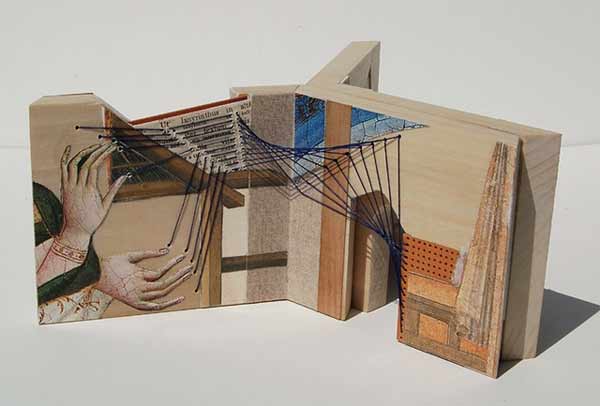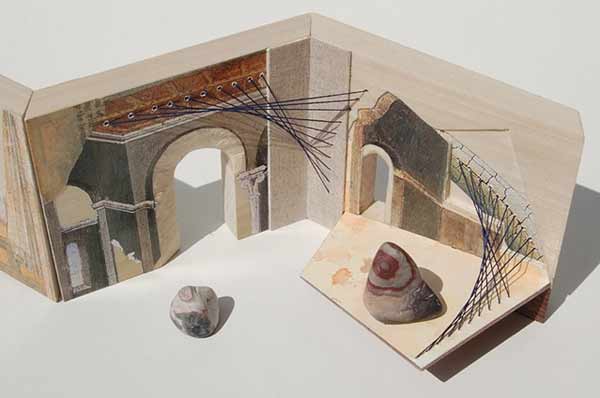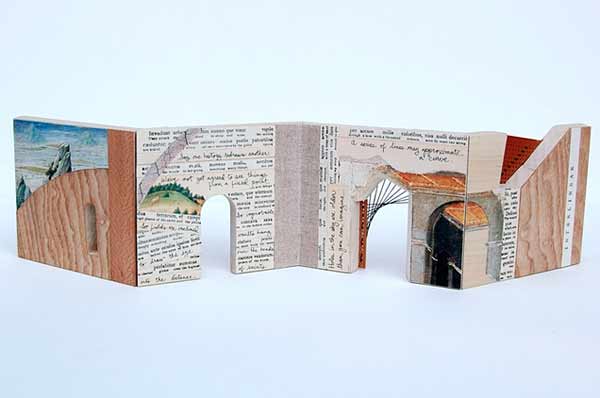In 2011, Susan Collard crafted Interlinear, a wooden accordion-like structure collaged with various imagery and texts. I’m particularly attracted to the inclusion of delicate embroidery threads; connecting the illustrations in a playful manner and drawing the viewer’s eye from page to page through doorways and into secret compartments.
During my first year at North Bennet Street School, the students were invited to aid in the set-up of the Marking Time Exhibition at Dartmouth College. It was here that I first saw and played with Susan’s work. As we gathered around her work, we dropped one of the steel balls to investigate the hidden channels and pathways between each page.
Read the interview after the jump. Come back each Monday during the month of May for more posts about Susan’s work, which include in progress photos for A Short Course in Recollection and more detailed images of Camera Obscura.
1. You work primarily as an architect, making artist books in your spare time. Although I’m not trained as an architect, I can see correlations between the two mediums. Can you talk about how architecture and book arts complement each other, especially in your own work?
When I studied architecture, we were taught to think of buildings in terms of their spatial sequence. An artist’s book acts like a building in a lot of ways: it presents façades, allows someone entry and passage through, creates places conducive to certain discoveries and functions. Books and buildings both unfold over time. But unlike, say, a film director, the architect and book artist can’t control the pacing or even the order in which their work is experienced. They create this artifact, which depends entirely on the actions of the reader, or the visitor to the building. I tend to think of my books along those lines–as an open structure to be played with and thought about, rather than read in a linear fashion.
In more specific terms, I use mostly non-traditional materials in my books, which demand different structures, different kinds of hinges. There’s a whole cascade of effects when you decide your pages are going to be made out of metal, stone, or plywood instead of paper. As an architect, I’m pretty comfortable with the kind of planning and problem-solving necessary to make that work. It’s liberating to conduct those experiments at such a small scale, with inexpensive materials, and on my own time.
2. Are your artist books an extension of your architectural work or do you see them as two separate creative outlets? I imagine that your architectural work is somewhat driven by client demands, whereas your artist books are driven by your own creativity. Do you find one medium inspiring the other?
I definitely see them as separate. My architectural practice is focused on residential remodeling and additions: the goals are my clients’ goals, and I’m generally working within the style of the existing houses. It’s creative and collaborative, but it’s not a form of self-expression the same way art or poetry is.
One thing that’s very central for me in both fields is working with something that already exists, in order to transform it. I don’t start with a blank page, or an empty site in a rural field, but with something that already has a history, associations, and material presence. Somehow this suits me. In the case of my books, it’s most apparent when I’m making an altered book. But it’s also true of collage and assemblage in general: I work surrounded by all this stuff I’ve gathered, and I get a lot of my momentum from juxtaposing, repurposing, and reinventing it all, putting it together in ways that were never originally intended.
3. Can you discuss your process for transforming an idea into a physical book? During the bookmaking process do you identify certain techniques or skills as being interchangeable between book arts and your architectural work?
Those are daunting questions! I think I tend to have very simple ideas, but I carry them out in ways that are often intricate and complex. I try to shift back and forth in my thinking between big and small picture. At different parts of the process, one will dominate, but both are always present. With my books, I plan as much as I need to, but not more. How much that is varies from book to book. There are always plenty of surprises along the way.
I’m not sure my work is driven so much by specific techniques or skills, but maybe by ways of working. I want each book to be its own animal, so they all have different rules and premises. I’m often responding to the theme of an exhibition I’d like to enter. I might start with the title, and let that be my guide. Maybe I’m trying out a new structure or material or medium. Some books are what I’ll call “a bee in my bonnet”, like the Camera Obscura or A Short Course in Recollection, where I set myself a rather nerve-racking technical challenge. Others, like Scudder’s History of the United States, are simply a response to a specific book. In that case, I’d paid a dollar for the book at an estate sale, and when I looked at it later it didn’t seem worth the shelf space. The task of pouring time and attention into something that initially seems useless and unlovable is pretty central to what I do. I am always picking up caterpillars in hope of making butterflies.
4. Over the years your work has really progressed substantially and in complexity and technique. How long have you been making artist books and where did you acquire your skills? How have your techniques and materials evolved over the years?
I first started making artist’s books in 1992. I had gone to Cornell University for a five-year architecture degree straight out of high school. I worked for three years in an architectural firm, then I went to the University of Arizona for an MFA in poetry. Obviously, I was a little wobbly about my career path. While I was at the U of A, I heard about a class in mixed media artists’ books taught by Judith Golden. I took it, and I just loved how everything finally seemed to come together for me.
Since then, I’ve taken various workshops and continuing ed classes, but I’m more or less self-taught. I’m more likely to take a class in woodworking or painting than book arts. I feel lucky to have the Oregon College of Art and Craft in town, because they have such a great range of classes.
My books have always used collage, and early on I got excited about using corrugated cardboard. I liked the thickness of the pages, how you could easily cut openings or peel away the layers. I made my first book with wood pages in 1996. At the time I was working out of a small apartment. I visited my parents, and my dad helped me cut the pages and fabricate brass hinges. At first I was pretty timid with wood as a material: I just didn’t have a lot of skills or tools. But I’m a pretty patient person, so if I do something the hard way while I’m learning it doesn’t kill me. Now I have a small basement studio with an adjacent workshop area. My favorite tools are a high-end miter box handsaw (from Lee Valley Tools) and a drill press.
5. Do you have any favorite resources for collecting objects and ephemera for your books?
Here in Portland, the Friends of the Library holds an annual book sale that is pretty phenomenal. My tradition is to work one or two volunteer shifts and buy plenty of books. And yes, I cut them up, but I’m also supporting a good cause. Aside from that, it’s mainly estate sales. My husband and I like to ride our bikes to them in the summer. And people will occasionally give me stuff. Or, say, our toaster stops working, so I take it apart. Once you find out how many really cool metal pieces there are inside a toaster, you can’t resist pulling one out of a free box someone’s left at the curb. I have to be careful to keep the collecting impulse from getting out of hand.
6. Why do you choose to make one-of-a-kind books? Are you interested in working with multiple editions in the future?
I’ve done one editioned book (The Recombinant Alice), but it’s just not my cup of tea. I am almost always working with one-of-a-kind materials, and figuring things out as I go along. That means I pour a huge amount of time into a single object, but I don’t have to be systematic about it. It’s meticulous but never repetitive. And, you know, it kind of keeps the marketplace out of the equation. I do have to put bread on the table, but that’s what the architecture practice is for. I feel like time spent in the art studio is my own.
Get a tour of Susan’s studio on her husband’s blog: Infinite Art Tournament: the Life and Times of Michael5000






Very interesting concept combining “soft” with “hard”
Would like to be considered for an “Artist of the Month”. Please send information.
Thanks,
Claire Jeanine Satin
Great interview! Thanks for posting this to the BOOK_ARTS-L. I’m really glad to know about your blog.
Glad to hear you enjoyed the interview. And now I know about your blog!! Thanks for your comment.